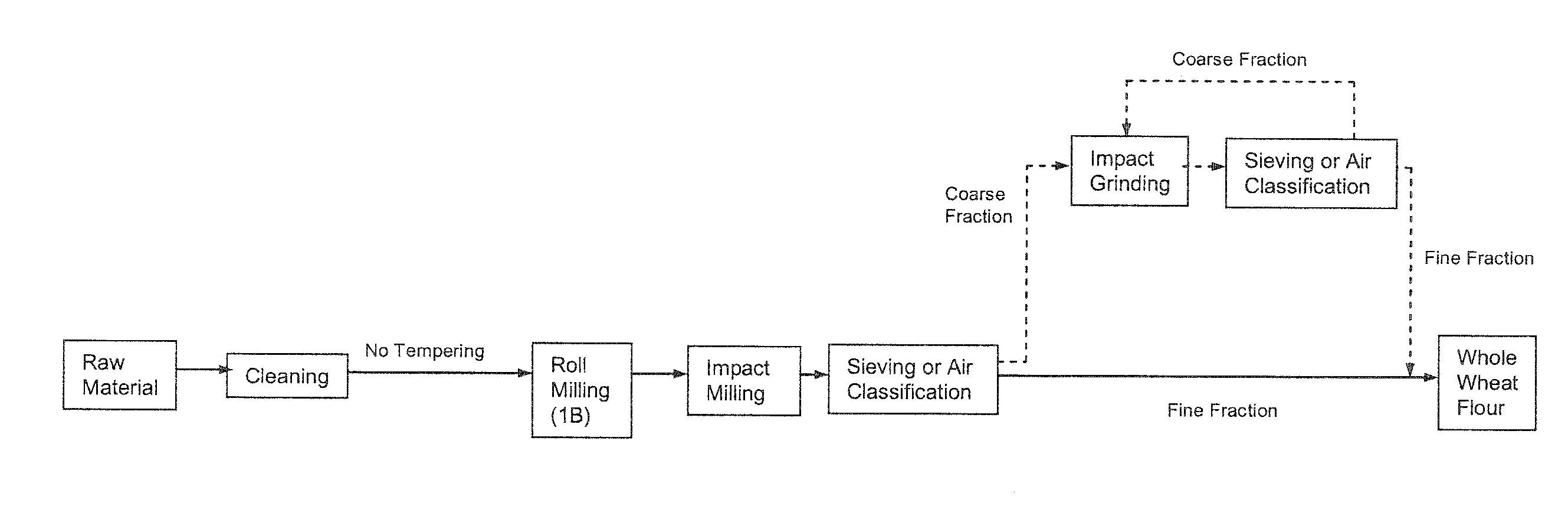Process of producing whole wheat flour
a technology of whole wheat flour and process, which is applied in the direction of grain treatment, bakery products, dough heat treatment, etc., can solve the problems of poor processability of meal, relatively large bran fragments, and reducing texture roughness, so as to achieve efficient production of whole wheat flour, reduce the damage to starch and gluten of wheat, and reduce the amount of grain
- Summary
- Abstract
- Description
- Claims
- Application Information
AI Technical Summary
Benefits of technology
Problems solved by technology
Method used
Image
Examples
example 1
[0041]Hard wheat kernels were cleaned and, without tempering, ground first in a roll mill (roll mill 1B) and then in a turbo mill (from Tokyo Seifunki Co., Ltd.) as an impact mill. The ground product was classified using a 150 μm aperture sieve into a fine undersize fraction (smaller than 150 μm) and a coarse oversize fraction (150 μm or greater). The average particle size of the fine fraction was 53 μm, and that of the coarse fraction was 321 μm.
[0042]The coarse fraction was pulverized using an impact pulverizer (ACM Pulverizer from Hosokawa Micron, Ltd.) and sieved using a 150 μm aperture sieve to collect a fine undersize fraction with a particle size less than 150 μm (a fine bran fraction).
[0043]The fine bran fraction was mixed with the previously separated fine fraction with an average particle size of 53 μm to obtain whole wheat flour for bread. The resulting whole wheat flour had an average particle size of about 50 μm and contained 0.3% of a coarse fraction with a particle si...
example 2
[0044]Hard wheat kernels were cleaned and, without tempering, ground first in a roll mill (roll mill 1B) and then in a turbo mill (from Tokyo Seifunki Co., Ltd.) as an impact mill. The ground product was classified using a 150 μm aperture sieve into a fine undersize fraction (smaller than 150 μm) and a coarse oversize fraction (150 μm or greater). The average particle size of the fine fraction was 53 μm, and that of the coarse fraction was 321 μm.
[0045]The coarse fraction was pulverized using an impact pulverizer (ACM Pulverizer from Hosokawa Micron, Ltd.) and classified using a 150 μm aperture sieve into a fine undersize fraction with a particle size less than 150 μm (a fine bran fraction) and a coarse oversize fraction with a particle size of 150 μm or greater. The undersize fraction was collected, while the oversize fraction was returned to the ACM Pulverizer and pulverized again, followed by classification in the same manner to collect a fine undersize fraction with a particle s...
example 3
[0046]Whole wheat flour for noodle was prepared in the same manner as in Example 2, except for using medium wheat for noodle in place of hard wheat.
PUM
 Login to View More
Login to View More Abstract
Description
Claims
Application Information
 Login to View More
Login to View More - R&D
- Intellectual Property
- Life Sciences
- Materials
- Tech Scout
- Unparalleled Data Quality
- Higher Quality Content
- 60% Fewer Hallucinations
Browse by: Latest US Patents, China's latest patents, Technical Efficacy Thesaurus, Application Domain, Technology Topic, Popular Technical Reports.
© 2025 PatSnap. All rights reserved.Legal|Privacy policy|Modern Slavery Act Transparency Statement|Sitemap|About US| Contact US: help@patsnap.com



